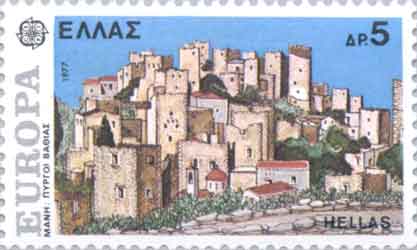|
|
"the Philosopher", the area inhabited by the Maniates was first called by the name "Maina" and was associated with the castle of Mezapos. The Maniots during that time were deemed pagan "Hellenes" or practitioners of pagan Greek culture (see Names of the Greeks) and were only Christianized in the 9th century. The Maniots were the last inhabitants of Greece to openly follow the Hellenic religion. This can be explained by the mountainous nature of Mani's terrain, which enabled them to escape the attempts of the Eastern Roman Empire to Christianise Greece by force. After the sack of Constantinople in 1204, which led to the division of the Eastern Roman Empire into small despotates, the Franks built three castles in the Taygetus. The Passava Castle was built near Githio, the Megalis Manis Castle ("Great Mani" Castle) or Mainis Castle was built on the western area of Taygetos and the Lefktrou Castle was built near Kardamili. After the defeat of Prince Wilhelm Villardouinos in 1259 near Pelagonia by Michael VIII Palaeologos, the three Peloponnesian castles of Mistra, Mani, and Monemvasia came under the control of a new ruler. The remaining castles of Mani eventually followed suit. After the Turkish conquest of Constantinople in 1453, the Maniots persisted in maintaining their autonomy. In May 1460, Sultan Mohammed II occupied the entire Peloponnese. The brothers of Emperor Constantine Paleologos XIV, Thomas and Demetrius, did not defend the Peloponnese against the Ottoman Turks. Instead, Thomas fled to Italy while Demetrius asked refuge in Sultan Mohammed's court. Gretzas Paleologos refused to surrender and defeated the Ottomans in Salmenico near Aegion. Korkodeilos Kladas also refused to capitulate and as the leader of the Maniots, he too fought off the Ottomans with success. From 1463 to 1479, the people of Mani defended their territories and sided with the Venetians during the Turco-Venetian War. Moreover, the Maniots prevented the Turks from building guard posts on their lands. Kladas was honored in Venice and acquired Venetian citizenship. During these tumultuous years, the entire Peloponnese revolted against the Ottomans. The territories of Patra, Mystras, Korinthos (Corinth), Sparta, and Argos were liberated. After the end of the Turco-Venetian War, the Venetians lost and they left the Maniots to fend for themselves. Many of the Greeks who had revolted alongside the Venetians were massacred by the Ottomans, but many of them fled to find refuge in Mani. Korkodeilos Kladas never accepted the clauses of the agreement made between the Turks and the Venetians. He not only refused Turkish offers, but he also began to revolt against them. He kept Mani as an autonomous region and also went to Northern Epirus to fight. However, he was captured in Heimara-Epirus and his body was severed into many pieces by his torturers. In 1571, the Ottoman fleet was annihilated in the Battle of Lepanto, and as a result many Greeks began to revolt in many places against the Ottoman Empire. The Maniots actively supported the Venetians and their brothers the Melissinoi (whose origins come from the Eastern Roman Empire) in which Metropolitan Makarios and Bishop Theodoros were the first among these supporters. In the 17th century, the uprisings in Mani occurred more often. An agreement for re-establishing the Byzantine state was made between Charles II Gonzalo, the prince of Never, and the Maniot Petros Medikos. Charles II Gonzalo, a descendant of Emperor Andronicus Paleologos, managed to contact the Pope, the King of France and the King of Spain, King Philip III. In the 17th century, the uprisings of the people of Mani became more frequent. The agreement was achieved with Charles II Gonzalo, the prince of Never who dreamed of restoring the Byzantine state, and the maniat Petros Medikos. Charles II was a descendant of Andronicus Palaeologus and came in contact with Pope, king of France and king of Spain, Philip III. This was the message sent by the Maniots to the Prince of Never. Unfortunately, Charles II Gonzalo was unable to help the Maniots being that his plans failed to acquire the military support he needed for he was only given promises by those he contacted. In 1645, a war between the Venetians and the Turks began in Crete. The Maniots supported the Venetians by offering them ships. In 1659, Admiral Francisco Morosini, with Maniots as his allies, occupied Kalamata, a large city near Mani. In order to make Mani surrender, the Turks attempted at best to flatter the unstable character of a Maniot pirate named Limberaki Gerakari, who fought against the Stefanopoulos family. With his assistance, the Turks built in Mani three fortresses. One in Kelefa, one in Zarnatas, and one in Porto Kagio. Very soon, the Maniot ports were weakened and Gerakaris took the responsibilities as a leader (i.e. general). Some time later, he realized what he had done to his fellow Maniots, took his pirate ships and attacked the Turks. In the end, he was caught and was imprisoned by the Ottomans. Later, he was summoned again to fight against the Greeks, but decided to flee to Italy where he died. In 1685, the Maniots fought with the Venetians under Morosini against the Turks. They succeeded in taking all of the fortresses and ousted the Turks from Mani, as well as from the entire Peloponnesian peninsula. Morosini fought against the Turks in Athens and in 1687 he damaged the Parthenon with his bombings. The damage was caused mainly because the Turks turned the Parthenon into a munitions depot, and one of the 800 shots fired from Morozini's forces struck the depot, which led to a massive explosion. As a result of the many revolts against the Ottoman Empire, the Maniots welcomed new Greek refugees from various areas including Asia Minor, and especially Crete when the Turks acquired the island from the Venetians in 1669. The Cretan refugees settled in Mani and created villages with Cretan names that enriched the Maniot dialect with Cretan words and idioms. The mass migration of refugees caused new problems in Mani. The limited area of good arable land led to many local wars between families, clans, and different villages. The era of vendetta began in Mani and it seemed that only a new Turkish invasion could save the country from a civil war. Many Maniot people began to serve as mercenaries in the army of the Doge while some others became pirates to fulfill their patriotic duties. In fact, the Turkish fleet near Chania, Crete was destroyed by Maniot pirates. Two well-known families from Mani were the Yatrianon family from Itilo and the Stephanopoulos family. The Yatrianon family moved from Itilo in 1670 to Livorno in Italy and the Stephanopoulos family moved in 1676 to Corsica (initially Paomia, ultimately Cargese). The Cargese settlers have maintained a distinct identity and to this day deem themselves "Greeks." In 1715, after the Venetians left the Peloponnese, Mani still retained its autonomy. The Turks decided to leave the situation in Mani unchanged and placed a bey (region administrator) to rule the area just like in Moldovlachia. The Maniots were told to pay 4,000 groshes a year, which they rarely did. During this period, there were many civil wars between strong Maniot families. These wars were vital in maintaining good practice for Maniots to become good and intrepid soldiers. In 1770, the Greeks revolted in the entire Morea. Constantine Kolokotronis (father of Theodoros Kolokotronis, hero of the Greek Revolution of 1821), Androutsos (father of Odysseas), Panagiotes Venetsanakis, Lampros Katsonis, and Zacharias fought against the Turks and used the Mani peninsula as their base of operations. The Russians left the Peloponnese without helping and 12,000 Muslim Albanians under Hatzi Osman suppressed the revolution and pillaged, massacred and burnt many cities and villages. Women and children were sold as slaves in Egypt and Syria. As the Maniots fought bravely, they defeated the enemy and Hatzi Osman was killed along with two-thirds of his army. The Muslim Albanians were so savage and atrocious during battle and after battle, that the Sultan sent the regular Turkish army under the command of Hashan Pasha. In 1779, the Muslim Albanians were exterminated with the help of the Greek klephts (bandits) led by Constantine Kolokotronis. At around 1780, Hashan Pasha with 10,000 men besieged the two towers in Kastania. The defenders were Constantine Kolokotronis and Panagiotes Venetsanakis with 150 men and women. The fight lasted for twelve days and most of the defenders were killed. The prisoners of war were tortured and dismembered. The wife of Constantine Kolokotronis was dressed like a warrior and fought her way carrying her baby who was Theodoros Kolokotronis, the future leader of the Greek Revolution of 1821. After the war of 1770, the Maniots were forced to pay the Sultan 15,000 groshes each year. From 1776 until 1821, eight beys ruled Mani. These beys were Tzanetos Koutifaris (1776 - 1779), Mikhailbeis Troupakis or Mourtzinos (1779 - 1782), Tzanetbeis Kapetanakis Grigorakis (1782 - 1798), Panagiotis Koumoundouros (1798 - 1803), Antonbeis Grigorakis (1803 - 1808), Constantinos Zervakos or Zervobeis (1808 - 1810), Theodorobeis Grigorakis (1811 - 1815), and Petrobeis Mavromichalis (1815 - 1821). In 1792, after the Russians made a treaty with the Turks, Lampros Katsonis said, "Aikaterini [Catherine] did her treaty but Katsonis didn't do his treaty with the enemy. Katsonis, Androutsos, and Zacharias fought Ottomans in Porto Kagio." Maniots, known for their martial qualities, were the first to join the Greek liberation movement. The society called the Filiki Eteria ("Company of Friends") sent their representatives Perrevos and Chrisospathis to organize the Maniots. On March 17, 1821, 12,000 Maniots gathered in the church of Taxiarchs (Archangels) of Areopoli and declared war against the Ottoman Empire. The flag of the revolution was white with a blue cross in the center. On top of the flag there was a sign: "Victory or Death." The Maniots were responsible for writing "Victory" and not "Freedom" on their banner being that Mani was always free. On the bottom of the flag lied an ancient inscription: "With the shield or on the shield."
On March 23, 1821, Petrobeis Mavromichalis, Kolokotronis, Papaflessas liberated the city of Kalamata. Most soldiers of the army were Maniots. On January 11, 1822, Ilias Mavromichalis, son of Petrobeis (leader of Mani), was killed at Karistos Evoia. The Turks cut his head off and sent it to the Sultan. The Battle at Vergas on June 21, 1826 was of great significance since the Egyptian leader Ibrahim lost two-thirds of his army, but his defeat was disgraceful when women of the Dirou village armed only with sickles and cudgels managed to throw the rest of his army into the sea. The history of the Maniots is a history both of suffering and of bravery. This history is reflected in the architecture of its castles, villages, and pirgospitia or "house-towers." Their Greek Orthodox churches of the 9th, 10th, and 11th centuries are the most ancient in all of the Peloponnese. See also Links The Pan Maniot Youth Union of Australia Maniots at the Struggle for Macedonia
Retrieved from "http://en.wikipedia.org "
All text is available under the terms of the GNU Free Documentation License Ethnic Groups
 |
|||||||||||||||
|
|

